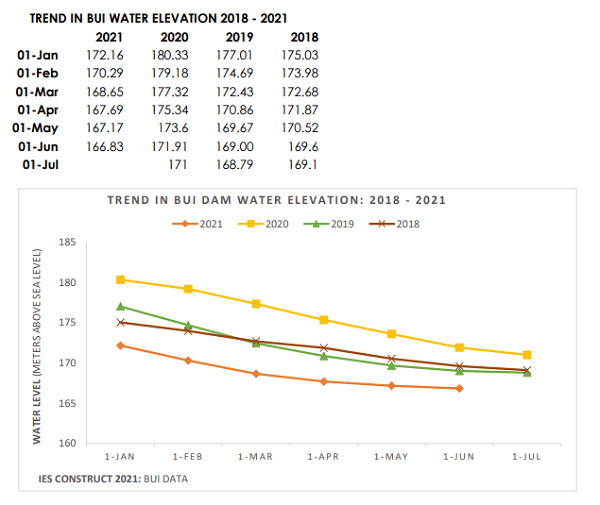The water level of Bui Power’s facility had dropped to its lowest at 166.83 meters above sea level (masl) by the end of May 2021, which is 1.17 meters below its minimum requirement of 168 meters a situation the Institute for Energy Security (IES) has ascribed to the huge demand for constant supply of power.
The IES, in a statement, added that instead of at least three units with dependable capacity of 360MW, only one unit of the plant is reportedly generating power of about 22MW at minimal levels; which means that, for the remainder of this year, the country cannot depend much on hydro power.
The hydro-electric plant, which is supposed to be peak-shaving plant a plant that comes on stream during peak time to augment supply has been operating below the recommended minimum operating water elevation of 168 meters above sea level (masl) since mid-March this year.
IES notes that due to non-adherence to the initial power supply recommendation for 2020, the Bui reservoir elevation dropped to a minimum of 166.82 at the end of May 2021; the lowest recorded since the Bui Dam was constructed.
“Data captured from the 2021 Electricity Supply Plan shows that the total hydro electricity generated for 2020 was 7,293.23 gigawatt-hours (GWh) as against the projected total of 6,897.2 GWh. This consisted of 5,164.45 GWh, 862.25 GWh and 1,269.52 GWh from Akosombo, Kpong and Bui hydropower facilities respectively,” the IES said in a statement.
Further analysis of the data also revealed that although the Bui Power generation station was projected to supply 764 GWh to the National Interconnected Transmission System (NITS) for 2020, the actual supply came up to 1,269 GWh a deviation of 65 percent from the initial plan.
The Power Planning Technical Committee (PPTC) revised the initial planned 764 GWh to 1,218 GWh during the mid-year review of the 2020 Electricity Supply Plan, since the facility had to produce more than anticipated to fill a supply deficit from other power plants.
Meanwhile, IES believes that upon noticing the drop in elevation below the recommended minimum operating water level was due to over-drafting of the lake to make up for power supply deficit, the most appropriate measure would have been to look beyond the Bui facility for peak-shaving this year. Additionally, it said, the facility has to be dispatched in a manner that adequate water can be stored in the reservoir during the 2021 inflow season.
Power supply hinges on thermal plants
The projected total annual hydro generation for 2021 is 7,001 GWh – consisting of 5,650 GWh from Akosombo GS, 850 GWh from Kpong GS and 501.2 GWh from Bui GS. Combined, the expected power supply from hydro will not be enough to meet demand; meaning the country will have to depend largely on thermal sources.
“It is therefore recommended that there should be proper coordination to ensure adequate provision of fuels such as natural gas, light crude oil and heavy fuel oil for the thermal plants, which are expected to generate over 66 percent of the power required for 2021,” IES added.
